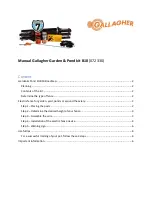
Remotes of type 102 or 112 are equipped with three cables. The first cable is used for connecting the remote to the series
circuit transformer with a FAA style 1 compliant cable. The second cable, having a FAA style 3 compliant connector, is used to
connect the remote to the first light to be controlled or monitored. The third cable, having also a FAA style 3, compliant
connector is used to connect the remote to the second light to be controlled or monitored.
1. Connect the first remote cable with a FAA style 1 the compliant plug to the CCR.
2. Connect the second cable to the light or sensor with the FAA style 3 compliant connector to the (first) light.
3. Connect the third cable to the light or sensor with the FAA style 3 compliant connector to the (first) light if you purchased
a remote of type 101 or 111.
Tip
Seal all the connectors with shrink tubes or insulating tape.
All the remotes can be — just like the series circuit transformers — fitted in any arrangement and at any orientation.
Tip
It is recommended to mount the remotes horizontally or vertically one next to the other into the installation frame,
with the cables hanging down, to enable easy access and maintainability.
NOTICE
The remotes and the connectors should not lie permanently in water.
The parameterizing process can be executed by the manufacturer as well as at site directly in line within the series circuit
or using the parameterizing tool (RFID handheld reader DRH100). The applicable method depends on what requirement
(regarding planning) exist for the lighting series circuit.
All the parameters are stored permanently in the Electrically Erasable Programmable Read-Only Memory (EEPROM ) of the
remote. Typical parameters are for example the fail-safe mode, the light address(es) (numbers) and one out of two
segment addresses the remote can belong to.
Data for planning for every remote consists typically of the following parameters:
•
remote type
•
number of the lighting segment
•
remote number in the series circuit
•
segment addresses to be listened by the remote
•
the unique identifier (remote ID which equals the light ID)
•
mounting position
Note
Individual control and re-parameterization with other settings in the active series circuit using the individual
series number is possible at any time.
NOTICE
You should install remote in a frame or on amounting rail to avoid cable breakage and prevent water from
entering the enclosure. Proper installation in the slots simplifies work in the slot as cable connections can be
followed easier.
RELIANCE Intelligent Lighting
Installation
42
Copyright
©
ADB SAFEGATE, All Rights Reserved
Summary of Contents for RELIANCE Intelligent Lighting Platform III
Page 1: ...RELIANCE Intelligent Lighting Platform III User Manual UM 5005 Rev 004 2020 08 06 ...
Page 2: ......
Page 10: ...RELIANCE Intelligent Lighting List of Figures x Copyright ADB SAFEGATE All Rights Reserved ...
Page 12: ...RELIANCE Intelligent Lighting List of Tables xii Copyright ADB SAFEGATE All Rights Reserved ...
Page 18: ...RELIANCE Intelligent Lighting Safety 6 Copyright ADB SAFEGATE All Rights Reserved ...
Page 52: ...RELIANCE Intelligent Lighting Introduction 40 Copyright ADB SAFEGATE All Rights Reserved ...
Page 56: ...RELIANCE Intelligent Lighting Installation 44 Copyright ADB SAFEGATE All Rights Reserved ...
Page 118: ......
















































